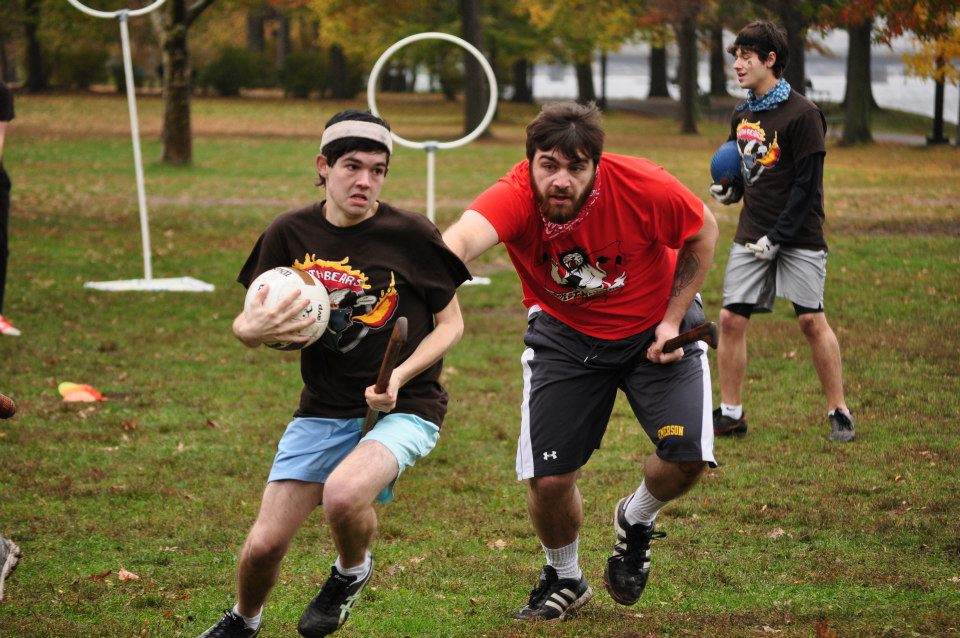- Rule, Britannia, no more?
- Unpopular Opinions: US Quadball Cup 2023
- Proven Contenders: University of Virginia
- Proven Contenders: Rutgers University
- Proven Contenders: University of Michigan
- Proven Contenders: Creighton University
- Different Perspectives: A Look Inside USA Ultimate
- Antwerp QC, Much of Belgian Core, Leaves Competitive Quidditch
Sustaining Success at a Small School: Intramural Leagues
- Updated: January 22, 2013
We will be publishing guest articles on a semi-regular basis. If you are interested, please contact us at editors@eighthman.com. This submission is from David Fox, a keeper at Emerson College; we hope you enjoy it!
As quidditch has continued to evolve and become more popular, the bigger colleges have begun to dominate the upper ranks of the sport. I think we can all agree that this is not by chance. These schools have a much larger talent pool to draw from, meaning there’s a higher chance of finding talented athletes who are interested in playing quidditch. Currently, all but two teams in The Eighth Man top 10 have a student body of 10,000, with the exception of Villanova University and my school, Emerson College.
Emerson has a population of a mere 3,000. So, how is it that we are able to maintain our position as an elite team, even when these other schools have access to so many more potential players? There has to be something we do that other schools don’t. Do we undergo unimaginably rigorous training? Spend hours obsessively watching film? Are we on steroids? The correct answer is none of the above. I’d say that one of the biggest reasons why Emerson, a tiny liberal arts college that supposedly is too cool for organized sports, can manage to continue to put up results at the highest level is because of our intramural league.
For those who don’t know, Emerson has a six-team intramural league consisting of over 200 people. We play pretty much every weekend once the season starts, and the league has become more and more competitive every year.
But how does this benefit our World Cup team? Well, for starters, it gives our World Cup players a lot of valuable experience playing in actual quidditch games. For many teams at other schools, obstacles such as distance and funding can make it tough for their players to get enough live-game experience outside of practice scrimmages, forcing them to need to readjust to the sport at its highest level every time they attend a tournament.
But, thanks to our house-league, we’re playing real games at least two or three times a weekend. These games are a great way for our World Cup players to work on their skills and to try out new skills and strategies that we wouldn’t necessarily want to risk in an intercollegiate game, like long-range beats, alley-oops and long shots.
Another great benefit of having a house-league is that it gives players who aren’t quite skilled enough to make the World Cup team a chance to develop their skills. This is key, because instead of simply being relegated a practice squad, these players are out there playing games against good competition every weekend. That way, when a spot on the World Cup team open up, we can usually fill it up with someone who already has plenty of experience in competitive matches.
Last spring, for example, one of our beaters broke his foot a week before Champions Series, leaving us with only one male beater. For many teams, that would mean that the remaining male beater would have to just suck it up and play the entire tournament, or they would have to take force one of their male chasers to serve as a beater for the tournament instead. But, thanks to our house league, we were able to add a beater who already had extensive experience at beating. I don’t think there are many teams out there who could find a high-caliber replacement so easily.
House-league also provides experience in an area that’s pretty hard to get in any other way: captaining a quidditch team. At schools where there is only a World Cup team, only one or two people can get experience captaining at a time. And when those captains move on or graduate, someone will have to plunge in without much experience in that role. Emerson’s World Cup captains, on the other hand, always go into the job with experience captaining a quidditch team. Each house league team has two captains, both of whom are usually World Cup players. Benny Nadeau, our current World Cup captain, already had three semesters’ of experience before he took over the position.
There are so many factors involved in captaining a quidditch team, and it can definitely be overwhelming at first for people who are new to it. It can be a daunting task to try and put a team together and to get them working cohesively in the few weeks before games and tournaments start. Luckily for us, we will always have a captain who has done the job before – it’s actually a rule that the World Cup captain has to have already been a house-league captain.
The truly elite quidditch teams are becoming more and more synonymous with the nation’s biggest universities. But perhaps university size isn’t the only determinant in sustained quidditch success. With the proper framework, a large and sustained intramural league can be just as important in keeping a school amongst the elite.


One Comment